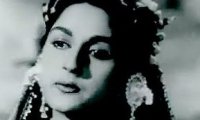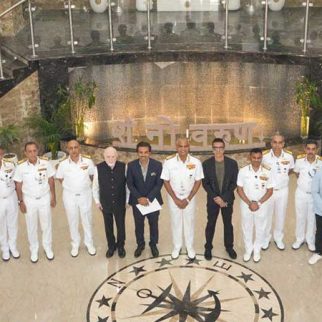
Over the last six decades, it is indeed a fascinating exercise to see which films proved the topmost hits in their respective years at the box-office. Their successes proved eye-openers not just for film buffs, industry and trade but frequently for their makers themselves, proving that hits happen and cannot be designed!
Numero Unos- A Survey of the Top Hit Films: 1950sIn a new 7-part series, we examine the films that have topped the box-office each year from 1950-2011 and get into a decade-wise analysis, keeping in mind the timeframes of their release and other interesting phenomena about them.
The 'rolls' of honour
Amazing but true –the biggest hit of the very first year under discussion – 1950 - was Filmistan’s Samadhi, a thriller set during India’s freedom struggle, narrating a claimed real-life incident in the life of Netaji Subhash Chandra Bose.
And what a wide variety we saw in the Numero Uno hits of this decade, when India was just celebrating the joys of newfound Independence and yet recovering from the aftermath of Partition traumas and facing new problems and internal socio-political conflicts!
The nine other winners of the '50s after Samadhi were:
Awara, a social (1951)
Baiju Bawra, a musical with a historical base (1952)
Anarkali, a historical romance (1953)
Nagin, a costume fantasy (1954)
Shree 420, a social (1955)
C.I.D. , a crime thriller (1956)
Mother India, a social (1957)
Madhumati, love story based on reincarnation (1958) and
Anari, a social (1959)

The common thread
The only surefire common thread that ran through all these films was their huge connect with the audience regardless of genre, proving that the ticket-paying viewer was extremely smart in demanding variety and standout fare.
Significantly, five of the ten films were produced by just two banners – Filmistan (Samadhi, Anarkali, Nagin) and RK Films (Awara, Shree 420). Raj Kapoor, producer-director and actor of the latter two films, was also the hero of Anari. Together, these three films best epitomized the brand image Raj successfully created for himself - of the Chaplin-esque underdog. Ashok Kumar was a producing partner with Filmistan in Samadhi and Guru Dutt, also an actor-filmmaker, produced C.I.D. but did not star in it. And even in later decades, home productions of stars garnered a significant chunk among BO toppers!
Though the top hits indicated the superstar status of Ashok Kumar and the new Trinity of Raj Kapoor, Dilip Kumar (Madhumati) and Dev Anand (C.I.D. ), it was always the film that made the star: Bharat Bhushan’s (and even Meena Kumari’s) innings took off only with Baiju Bawra. Sunil Dutt, Rajendra Kumar and Raaj Kumar broke through with Mother India, while Waheeda Rehman made her debut in a negative role with C.I.D. Even Bina Rai really hit big-time with Anarkali, while leading man Pradeep Kumar set off on the highway to stardom with his two consecutive Numero Unos – Anarkali and Nagin, incidentally the last two highs in the career of common director Nandlal Jaswantlal who had started out in the silent era!
It is interesting to see that the '50s had the maximum female-centric super-hits – besides Anarkali, there were Nagin and Madhumati (both Vyjayanthimala) topped by Mother India with that ultimate protagonist - a strong, rooted Indian woman who could be Lakshmi, Saraswati as well as Durga when needed - immortalized by Nargis. Raj Kapoor and Nargis led the star-roster with three films each, two of them (Awara, Shree 420) as co-stars.
The final common factor to all films was their popular music scores. Come Shankar-Jaikishan, the bright new whizkids in the three Raj Kapoor films, O.P.Nayyar (C.I.D. ), C.Ramachandra (Samadhi and Anarkali), Naushad (Mother India and his creative acme – Baiju Bawra), Salil Chowdhury (Madhumati, considered his tour de force) or Hemant Kumar (Nagin, ditto), it showed how music would always be the major factor in giving a film both a great 'opening draw’ and also a second-time watch repeat value.
The chartbusters, too numerous to mention, included 'Gore Gore O Baanke Chore’ (Samadhi), 'Awara Hoon’ (Awara), 'Tu Ganga Ki Mauj’ (Baiju Bawra), 'Yeh Zindagi Ussiki Hai’ (Anarkali), 'Man Dole Mera Tan Dole’ (Nagin), 'Mera Joota Hai Japani’ (Shree 420), 'Yeh Hai Mumbai Meri Jaan’ (C.I.D.) and 'Suhana Safar’ (Madhumati) as the crème-de-la-crème. Lata Mangeshkar, Mohammed Rafi and Mukesh were clear favourites.

Leading the pack
Mother India’s success was a spectacular, Technicolor trouncing of 1957 heavyweights like Naya Daur, Pyaasa, Do Aankhen Barah Haath and Tumsa Nahin Dekha to clinch the top spot. No other year in the '50s had such serious competition, and that music alone never made any film a blockbuster was borne out by the superior soundtracks of all those near contenders!
Ranking among Hindi cinema’s all-time biggest blockbusters, Mother India, in an era when movie tickets cost a rupee or less, did a business of Rs 4 crores! The film, produced and directed by Mehboob Khan as an updated remake of his '40s film Aurat, is the only one in this elite list to make it to the Oscars shortlist for Best Foreign Film.
Setting trends and a pattern
There seemed to be a clear preference for socials with messages in the prevalent euphoric yet confused and thus turbulent society where films had to reflect realities and yet offer relief from everyday problems. Even Baiju Bawra, Anarkali and C.I.D. commented on society, and only Nagin and Madhumati were about only entertainment.
If this decade saw filmmaking legends like Raj Kapoor (Awara and Shree 420) Vijay Bhatt (Baiju Bawra), Bimal Roy (Madhumati) and Mehboob Khan (Mother India) earn new laurels, it also witnessed the career breakthroughs of future aces like Raj Khosla (C.I.D. ) and Hrishikesh Mukherjee (Anari). Kapoor, in particular, maintained an incredible record of at least one Numero Uno film for each of his active five decades – before Awara there had been the path breaking Barsaat in 1949, and he was to follow up with Sangam (1964), Bobby (1973) and Ram Teri Ganga Maili (1985)!

Awara is, as we know, the first Indian film to make a solid mark outside the country – its music, like the movie itself, became a rage in Russia and many other nations to the extent that the names Raj Kapoor and Nargis and the song 'Awara Hoon’ became synonyms for India and were akin to magic wands that opened doors and hearts for touring Indians! Baiju Bawra, on the other hand, gave an impetus to the use of simplified Indian classical music in cinema, and Nagin and Madhumati were the respective forerunners of many later fantasies about snakes in human form and reincarnation dramas.
There were some truly piquant trivia: Madhumati’s climax was rehashed in Om Shanti Om, the top hit of 2007, while Anarkali’s tragic love for Prince Salim would be depicted again in an all-time hit just after this decade ended - Mughal-E-Azam in 1960.
Shashi Kapoor, a child star in both Samadhi and Awara, was to feature in just two multi-hero films later in this elite list – Waqt and Roti Kapada Aur Makaan. Shree 420 was recycled as Shah Rukh Khan’s Raju Ban Gaya Gentleman and Deewaar was admittedly part-inspired by Mother India. And yes, funster Mehmood had a tiny standout cameo as a hired killer in C.I.D. !
[To Be Continued]
BOLLYWOOD NEWS - LIVE UPDATES
Catch us for latest Bollywood News, New Bollywood Movies update, Box office collection, New Movies Release , Bollywood News Hindi, Entertainment News, Bollywood Live News Today & Upcoming Movies 2024 and stay updated with latest hindi movies only on Bollywood Hungama.






